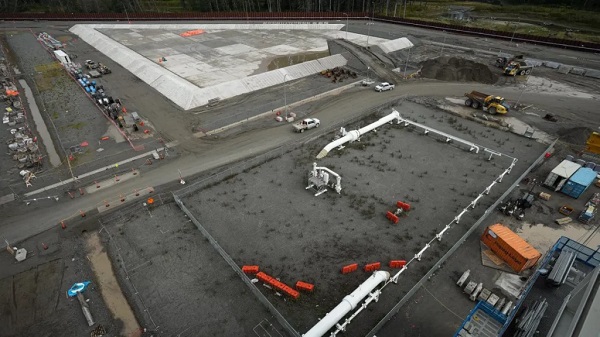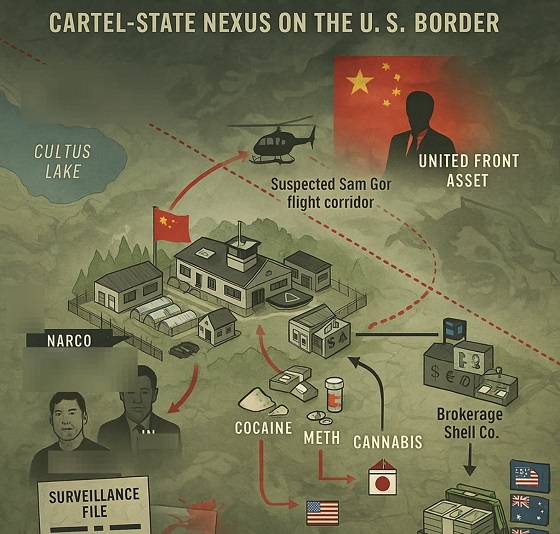RCMP
Over $100,000 cash seized by RCMP in Red Deer drug bust

News release from Alberta RCMP
Red Deer RCMP arrest individual for drug trafficking
On Jan. 22, 2025, Red Deer RCMP General Investigation Section (GIS) arrested one male as a result of a drug trafficking investigation.
Police executed search warrants on a residence and motor vehicle in the Red Deer area. As a result of the investigation, police seized over 16 ounces of cocaine that had been pre-packaged for sale and also pressed into a brick form, 140 Oxycodone tablets, items used in the trafficking of controlled substances and over $100,000 in Canadian currency.
Ermias Yohannes, a 36-year-old resident of Ontario, has been charged with the following offences:
- Possession of a Controlled Substance for the Purpose of Trafficking x2
- Possess Proceeds of Crime over $5000
Yohannes was brought before a Justice of the Peace and was remanded into custody. He is scheduled to appear in court on Jan. 30, 2025 at the Alberta Court of Justice in Red Deer.
“Red Deer RCMP remain committed to improving public safety and disrupting drug trafficking activities within our communities” said Cst. Andrew Devine, Red Deer RCMP GIS.
If you have information regarding this event or any other suspicious or illegal activity within the City of Red Deer, please contact Red Deer RCMP at 403-406-2200. If you wish to remain anonymous, you can contact Crime Stoppers at 1-800-222-8477 (TIPS), online at www.P3Tips.com or by using the “P3 Tips” app available through the Apple App or Google Play Store. To report crime online, or for access to RCMP news and information, download the Alberta RCMP app through Apple or Google Play.
Crime
Hybrid threats, broken borders, and organized chaos—transnational organized crime in Canada

By Peter Copeland & Cal Chrustie for Inside Policy
Transnational organized crime is ‘no longer just criminal,’ it’s become a geopolitical weapon, says Chrustie.
As geopolitical tensions rise and domestic vulnerabilities deepen, Canada is increasingly being used as a conduit for foreign adversaries waging hybrid warfare against the United States and its allies.
From fentanyl pipelines and money laundering to campus radicalization and weak border enforcement, a concerning picture emerges of transnational organized crime (TOC) networks operating with strategic alignment to states like China, Iran, and others.
In this edition of Inside Policy, Peter Copeland, deputy director of domestic policy at the Macdonald-Laurier Institute, sits down with Cal Chrustie, a former RCMP senior intelligence officer with deep experience in national security and transnational crime.
Chrustie tells Copeland that TOC is “no longer just criminal,” it’s become a geopolitical weapon.
“It’s about destabilizing communities, overwhelming public services, and hollowing out social cohesion,” says Chrustie.
He explains that Canada is not presently well-positioned to respond to this threat.
“Canada’s legal framework is designed for a domestic, rule-of-law environment,” he says. “It’s ill-suited to confront global adversaries who don’t play by those rules.”
Their wide-ranging conversation reveals the structural, legislative, and cultural weaknesses that have left Canada uniquely vulnerable to hybrid warfare and interconnected threats—and explores what a meaningful response might look like.
Copeland: Let’s start with fentanyl. In 2023, the U.S. Drug Enforcement Administration estimated over 70,000 fentanyl-related deaths. A growing number of precursor chemicals are sourced from China and routed through networks in Mexico and increasingly Canada. How is fentanyl trafficking being used strategically by foreign actors?
Chrustie: There’s no denying the scale of fentanyl production in Canada. It far outpaces our internal consumption. While there’s uncertainty around the volume reaching the U.S.—and certainly exaggerated claims by some Americans—we know Canadian labs are supplying Australia in large quantities. The broader concern is that we don’t know the extent of what’s crossing into the U.S. from Canada because we’re not meaningfully tracking it. That lack of visibility alone is a serious national security concern. Furthermore, the media focus has typically been China, China, China. While there are obvious signs of Chinese cartels in play, but what’s often dismissed is the role of Iranian networks.
Copeland: You touched on the issue of gaps in our understanding. At MLI, we’ve documented the minimal capacity we have at our borders—limited personnel, a very small percentage of containers and vehicles physically inspected, and mostly randomized or intelligence-led searches. Given these limitations, how can we even estimate the scale of fentanyl or other cross-border activity?
Chrustie: It’s a mistake to overly focus on the border. It’s a choke point, yes, but seizures there are often the result of intelligence generated far from the physical crossing—through complex global investigations, intelligence operations, surveillance, profiling, informants, machine learning. The U.S. has robust systems for this. Canada doesn’t. So, pointing to low seizure rates at the border as evidence of low trafficking activity is misleading and isn’t overly helpful in understanding the threat. It’s more relevant in understanding what we don’t know.
Copeland: We’ve proposed mandating more information-sharing from importers and exporters to support intelligence-based inspections. What are your thoughts on this approach?
Chrustie: Transparency helps, but you must consider the risk of compliance failure. If bad actors have infiltrated parts of the supply chain—shipping firms, port operators, truckers—then even detailed regulations won’t suffice without enforcement. Foreign state actors have the cyber capabilities to manipulate these systems too. It reinforces the need to address the problem systemically, not just tactically, and appreciate corruption and compromised systems are reality, not just a possibility.
Copeland: So, more than just piecemeal fixes?
Chrustie: Absolutely. We need a strategic, whole-of-society approach. Canada hasn’t yet conducted a serious intellectual review of why our system isn’t working. Political leaders fear what they’ll find, because it would demand systemic overhauls. These systems must take into consideration the broader threat activities and their interconnectivity with corruption, electoral interference, espionage, misinformation, and threat finance. Unfortunately, these connections are largely ignored, along with the strategic recognition that national security has a symbiotic relationship with economic security. If we were to take seriously the impact of national security on countless aspects of our social fabric—from crime, and social trust, to economic security—we would have a much more robust approach to transnational organized crime.
Copeland: Let’s take a step back. Most people probably picture transnational organized crime as gangs seeking profit, often disconnected from foreign governments. But you’ve argued that TOC is used by hostile states as a weapon in hybrid warfare. What does that mean, and how should we reframe our understanding?
Chrustie: Hybrid warfare is the blending of military and non-military means to weaken or destabilize a target. For hostile states, transnational crime is a tool—just like cyberattacks or disinformation. China, Russia, Iran, North Korea—the CRINKs—use TOC to raise money, create chaos, and undermine our institutions. TOC is no longer just criminal—it’s geopolitical.
Copeland: So the fentanyl flooding North America isn’t just a public health disaster—it’s also a weapon?
Chrustie: That’s right. It’s about destabilizing communities, overwhelming public services, and hollowing out social cohesion. Just like the Soviets used propaganda and the KGB used disinformation, modern adversaries use drugs, money laundering, and crime networks to erode their adversaries from within.
Copeland: Is Canada the main target, or are we a launchpad to attack the U.S. and our allies?
Chrustie: Both. Threat actors don’t view the Five Eyes or NATO countries in isolation—they see the alliance. So, attacks on Canada are also attacks on the U.S., Australia, the UK, and vice versa. They exploit Canada’s weaknesses, especially in places like Vancouver, where strategic assets such as ports, shipping companies and supply chain infrastructure are key hybrid warfare targets and impact the national and economic security of our allies. In the case of Vancouver, the intent is to target the US and Mexico (i.e. North America), through Vancouver-based assets as it’s a location of lower risk to operate in.
Copeland: You mentioned encrypted phone networks. Could you elaborate?
Chrustie: At one point, more encrypted communication companies linked to TOC and terrorist financers were based in Vancouver than anywhere else in the world. These platforms were used globally—by cartels, arms traffickers, terrorists, state proxies. That tells you all you need to know about how Canada is perceived by adversaries.
Copeland: What structural weaknesses are they exploiting?
Chrustie: First, we lack a national security strategy. Other countries—Australia, the U.S.—have all-of-government approaches. We don’t. Second, our institutions are siloed. Policing is on the front line, but CSIS, CBSA, military and CSE aren’t always integrated. Third, our systems—immigration, legal, financial—are outdated and easily gamed. Finally, there’s our culture: we’ve been complacent about national security.
Copeland: What does a serious strategy look like?
Chrustie: It starts with clear national priorities: identifying top threat actors (China, Iran, Russia, North Korea), coordinating agencies, aligning law enforcement and intelligence. It also means acknowledging our legal framework can’t always meet the challenge. Disruption and foreign operations—working with allies to stop threats before they reach our shores—will be critical. Also, the historical paternalist approach of governments and bureaucrats—of “we know best, and we won’t discuss these issues in public, it’s too sensitive and we are the experts,”—I think that’s dated, and China, Russia, Iran and North Korea are the biggest fans of this arrogant and naïve thinking. We need to shift immediately, engage the communities, business leaders, the legal community, and others. The solutions are in the communities, not in the siloed offices of governments.
Copeland: That raises a point about legal constraints. Are you saying our rights framework is part of the challenge?
Chrustie: Yes. Canada’s legal framework is designed for a domestic, rule-of-law environment. It’s ill-suited to confront global adversaries who don’t play by those rules. We either need carve-outs with enhanced powers for TOC-related and foreign threat activities investigations, or we need to rely more on foreign-facing disruption efforts—working abroad, with allies and accept prosecutions are secondary in measuring success. We can’t pretend that our current legal framework is workable, as the threat actors have figured this out and are taking advantage of it.
Copeland: Let’s talk about antisemitism and extremism. In the past year, we’ve seen a sharp rise on university campuses. What’s driving it?
Chrustie: Some of it is ideological, but we’re ignoring the role of transnational organized crime and foreign money. Iranian networks, for example, have long been tied to money laundering and extremist financing. These aren’t disconnected trends. The same threat actors behind fentanyl and money laundering are often involved in radicalization efforts. These are the same networks aligned to China and the Mexican cartels; they don’t operate in boxes. An old school bureaucratic lens on terrorism from the middle east, or terrorist financing analysis from a regional lens, is placing Canadians and others at risk.
Copeland: You’re suggesting that protests, radical activism, even antisemitic incidents may be downstream of the same networks enabling fentanyl and laundering billions?
Chrustie: Exactly. We’re talking about convergence. These networks exploit every vulnerability—from public health to political discourse. Failing to connect the dots between TOC, extremism, and foreign interference means we’re always reacting too late. Let’s look at the historic HSBC case, in which hundreds of millions had been laundered by the Sinaloa cartel due to lax anti-money laundering compliance by the bank, resulting in a $1.9 billion fine being levied against it. The same cartel networks that emerged through the HSBC probe are engaged in Canada today. Experts need to focus on what they don’t know versus what they think they know—look at the strategic and historical activities, accept that we are not in the middle east and accept the complexities of TOC of other activities, including terrorism and extremism.
Copeland: Lastly Calvin, I want to talk about the big picture. Evidently, Canada is seen as an easy target by our adversaries. What structural weaknesses are they exploiting?
Chrustie: This is where I think about it in four layers: strategy, structure, systems, and culture.
First, strategy. We lack a cohesive, public national security strategy. Unlike the United States or Australia, Canada doesn’t clearly define TOC as a strategic national threat. We don’t have a single, unified doctrine coordinating our federal agencies—police, intelligence, border services, foreign affairs. And without that, every department works to its own mandate, and TOC thrives in those gaps. We need to name top threat actors—China, Iran, Russia, North Korea—and make their proxies part of the strategy. We also need to shift from a policing mindset to one focused on disruption and prevention, including operations overseas.
Second, structures. Right now, the RCMP is expected to shoulder most of the burden. But that’s unsustainable. We need an all-agency model—where the Canadian Security Intelligence Service (CSIS), Canada Border Services Agency (CBSA), Financial Transactions and Reports Analysis Centre of Canada (FINTRAC), and Communications Security Establishment (CSE), the Department of Justice, Global Affairs, and others are all responsible for TOC enforcement and disruption. In the U.S., agencies are compelled to coordinate on TOC. In Canada, they’re siloed. And without a lead co-ordinating body or national TOC co-ordinator, those silos are growing.
Third, systems. Our legal system is outdated. Charter protections, disclosure rules from cases like Stinchcombe, and overly complex evidentiary requirements mean that complex cases fall apart or never get prosecuted. We also lack a dedicated foreign intelligence service like the CIA or MI6. Our immigration system is overwhelmed—there’s no way current vetting can match immigration volumes. And our financial system, particularly in real estate and casinos, has become a playground for laundered money. We need a legal and regulatory framework built for transnational threats, not 1980s-era domestic crime.
Fourth, culture. This is the most overlooked piece. Canadians are culturally indifferent to national security. We’ve taken a maternalistic approach—shielding the public from harsh realities, hoping to avoid panic or xenophobia. But that silence has allowed foreign actors to operate here with little resistance. Until we educate the public and foster a culture that values sovereignty and security, there will be no pressure to change the strategy, structure, or systems.
Copeland: Final thoughts?
Chrustie: We need to stop thinking of TOC as a law enforcement issue. It’s a military, intelligence, legal and most importantly, an all-Canada problem. There is no room for spectators. We need to stop thinking its someone isolated from all other threats and threat actors. It’s a national security crisis and its part of the slow play to weaken our political, social, and economic structures. We are years behind our allies. If we don’t get serious—strategically, structurally, and culturally—we will pay the price.
Copeland: Here’s my takeaways: In summary, we can see that Canada is uniquely vulnerable to transnational organized crime which makes it vulnerable for the broader foreign threats. Our agencies are siloed, and we lack a comprehensive strategy to effectively address issues like drug and human trafficking, to the presence of radicalization and extremism on our campuses. What’s more, our legal framework is such that we don’t have the same kinds of tools as our allies, that allows law enforcement, military, and intelligence agencies to act swiftly where issues of national security are in play.
Peter Copeland is deputy director of domestic policy at the Macdonald-Laurier Institute.
Cal Chrustie is a former RCMP senior intelligence officer with deep experience in national security and transnational crime.
Alberta
Bonnyville RCMP targeted by suspect driving a trackhoe – Update

From Bonnyville RCMP
On May 3, 2025, at approximately 6:55 p.m., a male suspect drove a stolen trackhoe into the parking lot of the Bonnyville RCMP detachment. Investigation has revealed that just prior to this occurring at the detachment, the suspect stole the trachoe from a local business. In the process of stealing the trackhoe, the suspect drove through a fence of the business, causing significant damage.
The suspect then headed to the detachment, picking up boulders along the way. He then dumped several boulders in front of the prisoner bay of the detachment, believed to be an attempt to delay officer’s ability to respond to calls. He then drove the trackhoe into 5 unoccupied parked police vehicles, making them inoperable. The suspect then fled from the detachment on foot.
Thanks to assistance from the RCMP RTOC (Real Time Operations Center), numerous resources were called in to assist, including St. Paul Police Dog Services (Chase), Cold Lake RPAS (drone), Eastern Alberta District General Investigation Section and Crime Reduction Unit and Elk Point Detachment. The real-time operations center is based out of K Division headquarters and is comprised of RCMP officers who are able to oversee and quarterback high risk incidents, such as this as they unfold. Their involvement in these types of incidents not only increase our chances of catching a fleeing suspect, but officer safety also increases. They are truly an invaluable resource.
Containment was set up and the search began for the suspect. A short time later, PDS Chase located the suspect hiding in a tree line just north west of the detachment. During his arrest, the suspect resisted and fought officers, and as a result, he was bitten by PDS Chase. Once in custody, he was taken to a local hospital to get treated for minor injuries and was released.

David Merko (62), a resident of Bonnyville, has been charged with 13 criminal code offences:
- Dangerous driving
- Mischief over $5000 (x6)
- Break and enter
- PSP over $5000
- Theft over $5000
- Obstruct/resist peace officer (x2)
- Utter threats
The last charge of uttering threats was as a result of an April 17th incident in which David Merko called OCC (dispatch) in Saskatchewan and uttered threats to kill RCMP officers.
After a Judicial Interim Release Hearing, Merko was remanded into custody for Alberta Court of Justice in Bonnyville on May 6, 2025.
Detachment Commander Staff Sgt. Sarah Parke states, “Incidents like this can be frightening for communities. In this instance, we believe there was no threat to the public and the RCMP was the target. Alberta RCMP officers from neighbouring detachments did not hesitate to assist to ensure the suspect was quickly taken into custody, as well as assisting with ensuring on-going police service in Bonnyville.
This incident has garnered a lot of attention on social media, and unfortunately, many of the comments are negative, some of which are threatening towards RCMP to the point of expressing disappointment that officers were not injured or killed during the incident. All RCMP officers come to work, day in and day out, to protect and serve their community. It is extremely disheartening to see these types of comments made.
Alberta RCMP have seen a steady increase in violence towards police in recent years. Most recent statistics indicate that on average, there are 2.3 incidents of violence occurring every day towards Alberta RCMP officers. In 2023, 70 Alberta officers were injured as a result of use of force incidents.
Thankfully, no one was injured during this incident.”
-
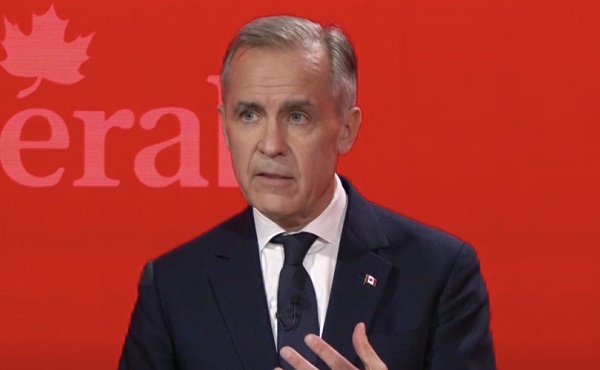
 Energy35 mins ago
Energy35 mins agoIs the Carney Government Prepared to Negotiate a Fair Deal for the Oil, Gas and Pipeline Sectors
-

 Health2 hours ago
Health2 hours agoJay Bhattacharya Closes NIH’s Last Beagle Lab
-
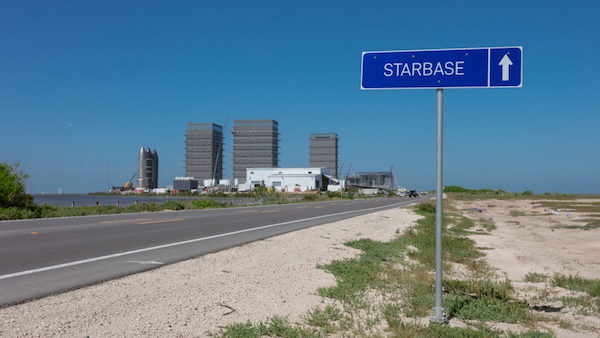
 Business3 hours ago
Business3 hours agoWelcome to Elon Musk’s New Company Town: ‘Starbase, TX’ Votes To Incorporate
-

 Crime2 days ago
Crime2 days agoHow the CCP’s United Front Turned Canada’s Legal Cannabis Market into a Global Narcotics Brokerage Network
-

 Alberta2 days ago
Alberta2 days agoAlberta Precipitation Update
-

 Daily Caller1 day ago
Daily Caller1 day agoStates Attempting To Hijack National Energy Policy
-

 Business2 days ago
Business2 days agoReal Challenges Await Carney
-
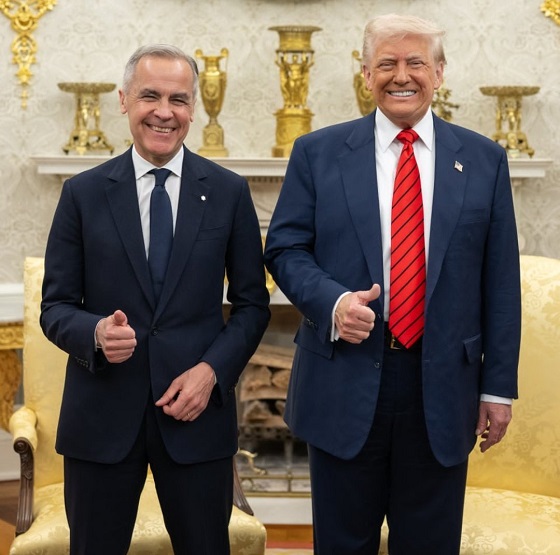
 Business23 hours ago
Business23 hours agoFrom ‘Elbows Up’ To ‘Thumbs Up’



